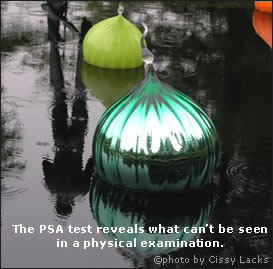Dr. Catalona’s Recommended Guidelines for PSA Screening
Differing comments are in the media regarding the use of PSA tests. In this article, Dr. Catalona, whose research developed the use of PSA tests for the early detection of prostate cancer, presents his personal and most recent recommendations for PSA testing. Some professional medical organizations endorse other guidelines for PSA screening. The one that comes closest to Dr. Catalona’s personal recommendation is the 2006 version of the National Comprehensive Cancer Network.

I believe that an initial PSA measurement and digital rectal examination should be performed at age 40 to assess baseline risk for prostate cancer.
PSA measurements and prostate examinations should be performed annually, and the results should be recorded so the PSA velocity can be calculated.
In my PSA Study, the median PSA value for the age group of men without clinical evidence of prostate cancer is 0.7 for men in their 40s, 0.9 for men in their 50s and 1.4 for men 60 years of age or older.
If the PSA is at the median or less for the age group, then the risk for prostate cancer is very low. If a man’s PSA is higher than the median for his age group, his risk of having prostate cancer is higher and the risk that the cancer is aggressive is higher. The higher the PSA, the higher the risk for cancer and aggressive cancer.
If the PSA is substantially above the median, I recommend a trial of antibiotics and repeat PSA measurements to see if the PSA comes down. If it doesn’t, I recommend a biopsy.
In any case, I recommend an initial biopsy if the PSA is persistently higher than 2.5 ng/ml.
Several studies have shown that in men without clinical evidence of prostate cancer but most of whom have benign enlargement (called benign prostatic hyperplasia or BPH), the PSA level increases approximately 0.1 ng/ml/year. If the total PSA is less than 4 ng/ml but the PSA velocity is greater than 0.3 ng/ml/year – verified with repeated measurements to rule out test variability– then I believe that rise in PSA calls for a biopsy.
If the PSA is higher than 4 ng/ml, a PSA velocity higher than 0.75 ng/ml/year should prompt a biopsy, even if a previous biopsy has been negative for cancer.
In all instances, rises in PSA should be treated with antibiotics and repeated PSA testing to rule out laboratory variation or prostatitis. Patients with dramatic increases in PSA are as likely to have inflammation in their prostate called prostatitis as prostate cancer.
PSA measurements are best made at least 48 hours after a prostate examination or ejaculation because either can raise the PSA level slightly.
Also, some medicines can affect PSA. Finasteride (marketed as Proscar or Propecia) and dutasteride (marketed as Avodart) can falsely lower PSA levels. Herbal preparations can also affect PSA levels, especially dietary supplements that are advertised “for prostate health.”
Patients should tell their doctors if they are taking any of the above medications of supplements.
In patients with a persistently high PSA who have an enlarged prostate gland, PSA density (PSA level divided by prostate volume) should be calculated. A PSA density greater than 0.1 ng/ml/cc should prompt a biopsy.
Similarly, the percent free PSA should be tested. If the percent PSA is higher than 25%, it is more likely that the PSA elevation is due to benign prostatic hyperplasia.
If the percentage of PSA is less than 10%, it is more likely that the PSA elevation is due to cancer.
Repeated biopsies can actually induce PSA elevations, so once a patient has had adequate biopsy sampling of the prostate, a moratorium on repeat biopsies should be called for one year to allow the prostate gland to heal from all of the previous biopsies.
If the PSA levels continue to rise, saturation biopsies under anesthesia including transurethral resection biopsies should be performed.
Definitions for Article:
Median PSA Value for Age Group is the value in the middle of all men tested in that age group. As many men tested above that value as tested below it.
PSA Velocity (PSAV) is the change or rise in PSA over time.
Prostatitis is a term used to describe inflammatory conditions of the prostate gland.
PSA density is the PSA value divided by prostate volume. Prostate volume is determined by a transrectal ultrasound (TRUS). A higher PSA density (PSAD) indicates a greater likelihood of cancer.
Benign Prostatic Hyperplasia (BPH) is noncancerous enlargement of the prostate.
FreePSA is the PSA that is in the blood but is not attached to blood proteins. The freePSA test shows how much PSA circulates free compared to the total PSA. The percentage of freePSA is lower in men who have prostate cancer than in men who don’t. A low percent-free PSA (less than 10%) is a strong indication for a biopsy. Biopsy recommendations should be considered for men whose percent freePSA is 25% or below.







